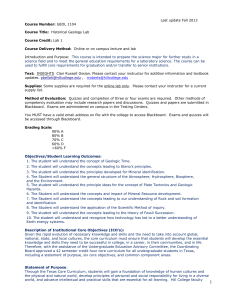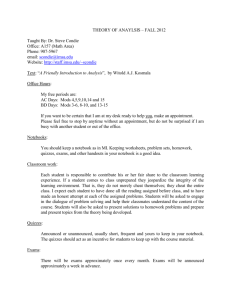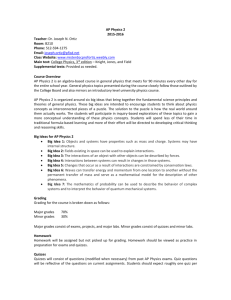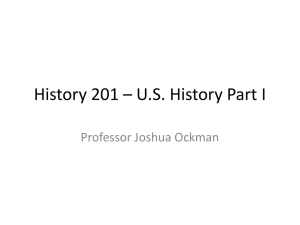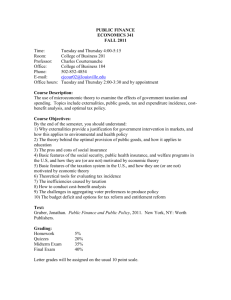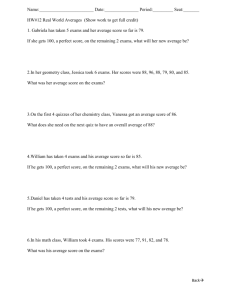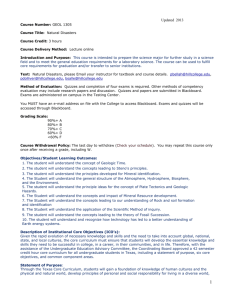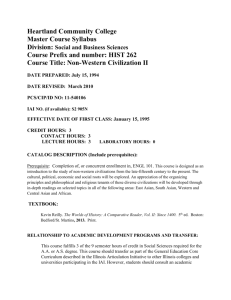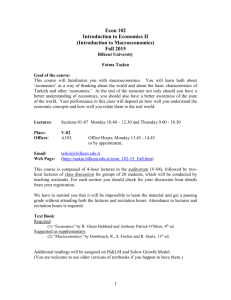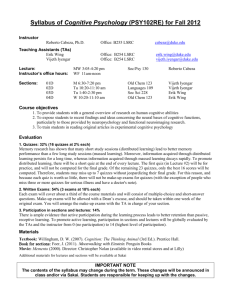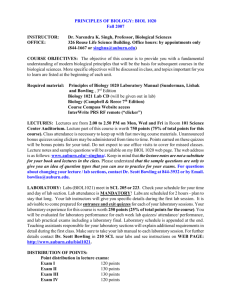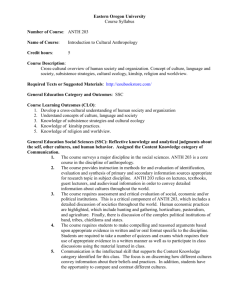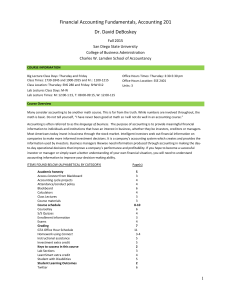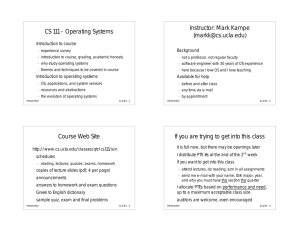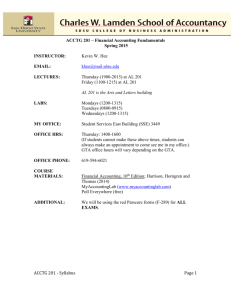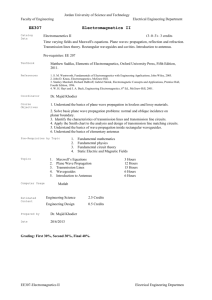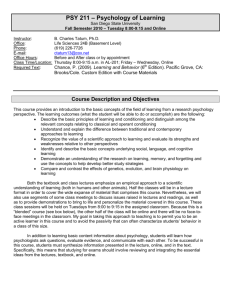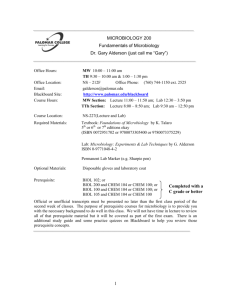STA 3033
advertisement
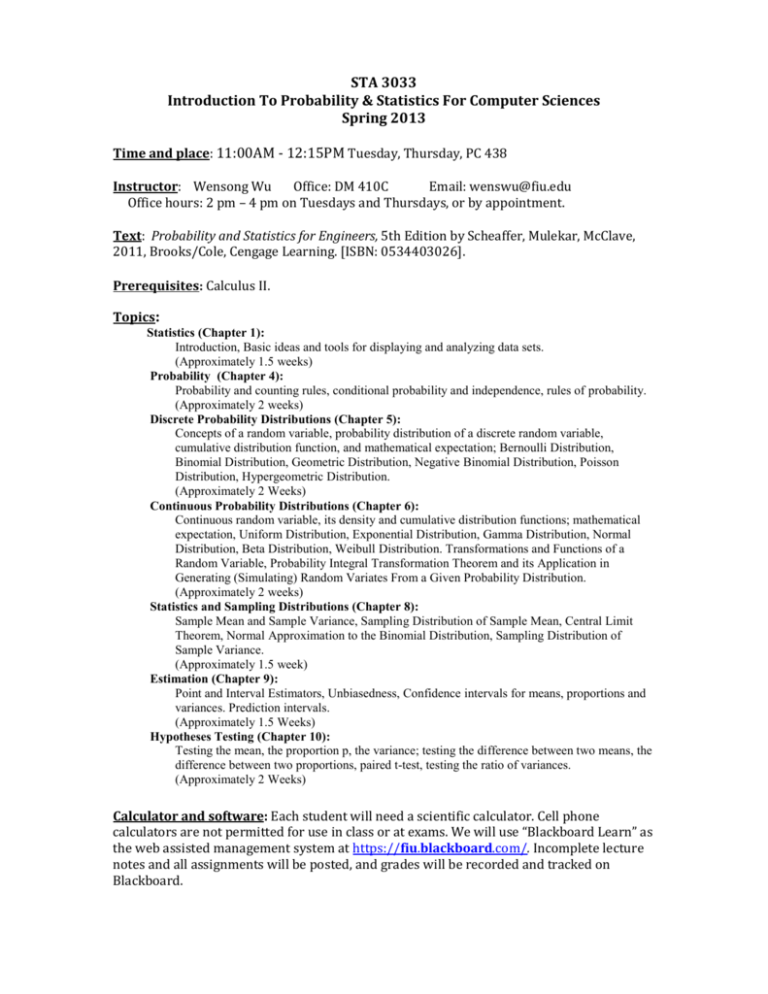
STA 3033 Introduction To Probability & Statistics For Computer Sciences Spring 2013 Time and place: 11:00AM - 12:15PM Tuesday, Thursday, PC 438 Instructor: Wensong Wu Office: DM 410C Email: wenswu@fiu.edu Office hours: 2 pm – 4 pm on Tuesdays and Thursdays, or by appointment. Text: Probability and Statistics for Engineers, 5th Edition by Scheaffer, Mulekar, McClave, 2011, Brooks/Cole, Cengage Learning. [ISBN: 0534403026]. Prerequisites: Calculus II. Topics: Statistics (Chapter 1): Introduction, Basic ideas and tools for displaying and analyzing data sets. (Approximately 1.5 weeks) Probability (Chapter 4): Probability and counting rules, conditional probability and independence, rules of probability. (Approximately 2 weeks) Discrete Probability Distributions (Chapter 5): Concepts of a random variable, probability distribution of a discrete random variable, cumulative distribution function, and mathematical expectation; Bernoulli Distribution, Binomial Distribution, Geometric Distribution, Negative Binomial Distribution, Poisson Distribution, Hypergeometric Distribution. (Approximately 2 Weeks) Continuous Probability Distributions (Chapter 6): Continuous random variable, its density and cumulative distribution functions; mathematical expectation, Uniform Distribution, Exponential Distribution, Gamma Distribution, Normal Distribution, Beta Distribution, Weibull Distribution. Transformations and Functions of a Random Variable, Probability Integral Transformation Theorem and its Application in Generating (Simulating) Random Variates From a Given Probability Distribution. (Approximately 2 weeks) Statistics and Sampling Distributions (Chapter 8): Sample Mean and Sample Variance, Sampling Distribution of Sample Mean, Central Limit Theorem, Normal Approximation to the Binomial Distribution, Sampling Distribution of Sample Variance. (Approximately 1.5 week) Estimation (Chapter 9): Point and Interval Estimators, Unbiasedness, Confidence intervals for means, proportions and variances. Prediction intervals. (Approximately 1.5 Weeks) Hypotheses Testing (Chapter 10): Testing the mean, the proportion p, the variance; testing the difference between two means, the difference between two proportions, paired t-test, testing the ratio of variances. (Approximately 2 Weeks) Calculator and software: Each student will need a scientific calculator. Cell phone calculators are not permitted for use in class or at exams. We will use “Blackboard Learn” as the web assisted management system at https://fiu.blackboard.com/. Incomplete lecture notes and all assignments will be posted, and grades will be recorded and tracked on Blackboard. Grading: Quizzes Assignments Exam 1 Exam 2 Exam 3 Final Exam Total 80 points (20%) 40 points (10%) 60 points (15%) 60 points (15%) 60 points (15%) 100 points (25%) 400 points (100%) A: 368-400 points [92%, 100%] A-: 356-367 points [89%, 92%) B+: 352-359 points [86%, 89%) B: 344-351 points [83%, 86%) B-: 320-343 points [80%, 83%) C+: 312-319 points [78%, 80%) C: 292-311 points [73%, 78%) C-: 280-291 points [70%, 73%) D: 180-279 points [60%, 70%) F: 0-179 points [0, 60%) Homework: Homework problems from the textbook will be assigned after each lecture, but no work will be collected or graded. The textbook has the answers to all odd-numbered questions. Solutions to other problems will be posted on Blackboard. Quizzes: There will be eight quizzes given at the beginning of randomly selected lectures in the weeks without exams. Each quiz is worth 10 points, where 2 points will be given upon attendance, and the other 8 points will be based on the performance of the quizzes. The quiz problems will be directly drawn or slighted modified from homework problems. No make up quizzes will be given unless extreme circumstances and documentation will be required. Assignments: There will be two written assignments, 20 points each. Students may discuss the assignment problems with each other but each student should submit their answers individually. No late assignment is accepted unless extreme circumstances and documentation will be required. Exams: There will be three midterm exams, 60 points each, and a comprehensive final exam, worth 100 points. Make-up exams will be considered only in extreme circumstances and documentation will be required. Also, you must notify me prior to the exam or the day of the exam if you think your situation merits a make-up. If you miss an exam for a valid reason but do not notify me of your situation in a timely manner (prior to or the day of the exam), then you will receive a zero on the exam. Individual work is required on exams. Attendance: Attendance will not be taken but strongly encouraged. However, quizzes and exams require attendance. Dates of Exams: Exam 1: 1/31, Thursday Exam 2: 2/28, Thursday Exam 3: 4/4, Thursday Final Exam: To be announced. Other important dates: 1/15: Last day to add/drop courses 3/12, 3/14: Spring break, no classes 3/18: Last day to drop a course with a DR grade 4/18: Last day of lecture All students should respect the right of others to have an equitable opportunity to learn and honestly demonstrate the quality of their learning. Therefore, all students are expected to adhere to a standard of academic conduct, which demonstrates respect for themselves, their fellow students, and the educational mission of the University. All students are deemed by the University to understand that if they are found responsible for academic misconduct, they will be subject to the Academic Misconduct procedures and sanctions, as outlined in the Student Handbook. How to succeed in this course 1. Attend lectures and don’t be late. Quizzes play a big portion in the overall score, and they will be given in the beginning of some lectures! 2. Download lecture notes before lectures, and take notes to complete notes during lectures. Review for exams according to my notes and instructions, instead of the textbook or other sources (your tutor’s notes or instructions for example). 3. Do homework problems! Although not collected, homework problems will appear in the quizzes. And doing homework problems after each lecture is the best way to practice and keep up learning. 4. Bring up your questions as soon as they come up, in lectures, by talking to me after class, or by shooting me emails anytime. Keep track of your scores on Blackboard. STA 3033 Review of Calculus (Could appear in Quiz 1) 1. 5! = ________. 2. Find the integral 3. Find the integral ò ò 1 x dx =_____________. 0 ¥ -x 0 e dx =___________. ¥ 2n 4. Simplify using Taylor expansion å =___________. n=0 n! STA 3033 Preparation Survey Results will only be used in anonymous data set. Thank you for your contribution! 1. Gender M 2. Age __________ 3. Major _____________ 4. Height in inches 5. You are currently resident: A. On campus F __________________ inches B. Off campus 6. If off campus, how long does it take to commute to school on a typical day? ____________ 7. What is the major way of shopping for the past holiday season? A. In store. 8. B. Online. C. Catalog. D. None of above How much did you spend on gifts during the past holiday season? A. Below $100 B. $100-$300 C. $300-$800 D. Above $800

